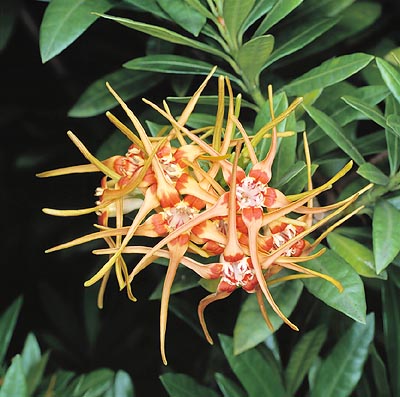Family : Apocynaceae

Text © Pietro Puccio

English translation by Mario Beltramini

Unusual stellate flowers. Suffers from the cold © Giuseppe Mazza
The name of the genus comes from the combination of the Greek words “strophos” = twisted cord and “anthos” = flower, with reference to the long extremities of the threadlike petals, especially when still in bud, of some plants belonging to the genus; the name of the species is the Latin name “speciosus” = beautiful.
Common names: “sand forest poison rope”, “forest tail-flower”, “corkscrew flower” (English); “Kletteroleander” (German).
Sarmentose, evergreen or semi-deciduous shrub, with stems parting in a trichotomous way, it shows verticillate leaves (three per each node), elliptic, long up to 10 cm, glossy dark green above, paler below. Terminal inflorescences, which appear by the end of the dry season, carrying flowers with long and thin petals of pale yellow colour with a brown red dot at the base of each petal. The fruits are follicles long up to 18 cm and a diameter of 1-1,5 cm, of a pale brown colour when ripe, containing pubescent 4-5 mm long seeds with a tuft of hair at the extremity to favour their dispersal. It reproduces by seed and by cutting.
Plant particularly suitable for subtropical and warm-temperate climates, preferably in full sun and in well drained soils; elsewhere, to be cultivated in pot in order to be sheltered in winter, as it does not bear temperatures even of few degrees below 0°C. All the parts of the plant contain potentially toxic substances, between which some cardiac glycosides, particularly present in the seeds.
Synonyms: Christya speciosa Ward & Harv. (1842); Strophanthus capensis A.DC. in A.P.de Candolle (1844).
→ To appreciate the biodiversity within the APOCYNACEAE family please click here.
